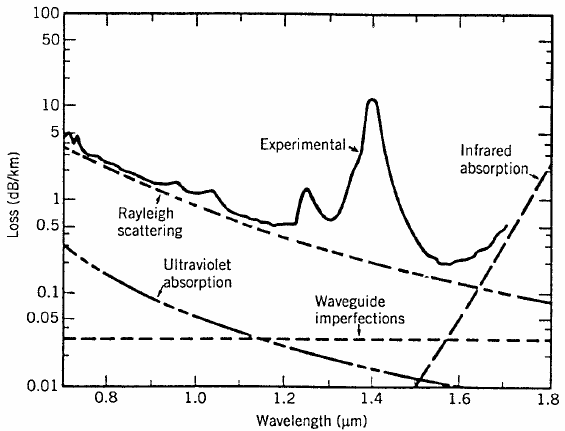Loss Mechanisms of Optical Fibers
Hi Steemians, in the previous article, we explained the history of the optical fibers and gave some information about optical fibers briefly. Today we will continue with an another parameter, loss mechanism of the optical fiber.
Another important parameter is an internal loss of optical fiber [1]. The intrinsic loss is how much optical power is transmitted to the other end of the fiber. The loss parameter is really important for especially high power fiber laser due to heat problem. For example, you have 1kW fiber laser system and if you have a loss about 5% then the dissipated heat will be 50W. If the loss becomes micron level then that point will burn easily (Do not forget, the melting temperature of silica which is core part, is about 2000 0C but the melting point of kind of plastic which is coating part, is about 200 0C). In general, the burning starts from the coating part. If P0 is the power level of the light at the input of a fiber of length L, the transmitted power of the light P T is given by
PT = P0exp(-αL)
α - the attenuation constant is a measure of total fiber losses from all sources.
As you see, the loss changes exponentially. So you can write it in form of dB/km.
αdB = -10(log(PT/P0))/L
The losses in optical fiber are loss of Material Absorption, Rayleigh Scattering, Imperfection of Waveguide, Stimulated Inelastic Scattering, Splicing and Bending losses.
1- Material Absorption [2]:
Material absorption can be considered in two categories. The first is internal absorption and the other is external absorption. Internal absorption is due to the resonance of the light with some specific molecules. For example, silica molecules used in general fibers form an electronic resonance [3] with ultraviolet wavelengths <0.4μm, while they generate vibrational resonance [4] with infrared wavelengths > 7μm. The resonance produced by the silica molecules is very small for wavelengths between 1.3μm and 1.6μm.

Ultraviolet absorption and infrared absorption can be seen in this figure.
However, external absorption occurs due to impurities in the fiber. The transition metals Fe, Cu, Co, Ni, Mn, Cr have a very high absorption at a wavelength of 0.6-1.6μm. Therefore, in order for this external absorption to be low, it is necessary to reduce it to a million of impure metals. Another cause of external absorption is the presence of OH- ions in the fiber. The vibrational resonance of the OH- ion is about 2.73μm. Although this range is not in the range supported by general fibers that are 1-2μm in wavelength, resonances of 2.73μm lead to 1.39, 1.24 and 0.95μm optical power loss. Today's modern technology has reduced the concentration of OH- ions to a very low level, and even this value is almost undetectable.
2- Rayleigh Scattering [5]:
The effect on the other optical power loss is Rayleigh scattering. This effect is related to the molecules that make up the fiber. During the fiber-making process, the silica molecules dissolve randomly and freeze. This randomness leads to differences for some refractive indices in micron level. Depending on the size of these randomly occurring silica molecules and the wavelength of the light, the scattering may be more or less. As shown Figure in the below, scattering decreases as the wavelength of light increases. For example, Rayleigh scattering causes the atmosphere its blue color.
3- Imperfection of Waveguide [6]:
The imperfection of the waveguide is also very important in terms of optical power loss. Perfection involves varying the core diameter and the refractive index. These variations cause optical power loss by directing the light in the wrong direction.
4- Stimulated Raman Scattering (SRS) [7] and Stimulated Brillioun Scattering (SBS)[8]:
These phenomena were about the nonlinear effects which is an another parameter of optical fibers. The main difference between the two is that optical phonons participate in SRS while acoustic phonons participate in SBS. These phenomena will discussed in nonlinear effect part.
5- Splicing [9] and Bending [10]:
Optical power losses due to fiber splicing and bending radius are usually mechanical problems. That is, they occur when fiber is used, not during fiber production. Fiber joining is the process of joining two or more fibers together with one or more other fibers through an electrical arc. If there are differences between parameters such as NA, Mode Field Area, or fiber structure of the joined fibers, it can cause a lot of loss in optical power transmission. Splicing fibers are another issue for optical fibers. We will discuss this issue in the next articles.
On the side of this, optical power losses that are caused by bending are very important especially in industrial areas. In fiber optic systems made for industry, fibers may remain bent to fit once. If excessive optical power loss is not desired, these bending radii must be well known. This radius is determined by the NA, as described in the previous chapters. The larger the NA, the less the twist radius can be.

You see that the red light which goes out inside the fiber parts due to the bending.
Up to now, we explained loss mechanism such as Material Absorption, Rayleigh Scattering, Imperfection of Waveguide, Stimulated Inelastic Scattering (SRS, SBS), Splicing and Bending losses of the optical fibers. From now on we will continue with the other parameters of the optical fibers such as dispersion, nonlinear effects.
If you have question or/and comments please write to us.
Have a curious day, Steemians...



This post has received a 3.07 % upvote from @drotto thanks to: @onderakcaalan.
I really like those very precious post of you. Keep going like this! Thank for sharing.
Congratulations! This post has been upvoted from the communal account, @minnowsupport, by onderakcaalan from the Minnow Support Project. It's a witness project run by aggroed, ausbitbank, teamsteem, theprophet0, someguy123, neoxian, followbtcnews, and netuoso. The goal is to help Steemit grow by supporting Minnows. Please find us at the Peace, Abundance, and Liberty Network (PALnet) Discord Channel. It's a completely public and open space to all members of the Steemit community who voluntarily choose to be there.
If you would like to delegate to the Minnow Support Project you can do so by clicking on the following links: 50SP, 100SP, 250SP, 500SP, 1000SP, 5000SP.
Be sure to leave at least 50SP undelegated on your account.